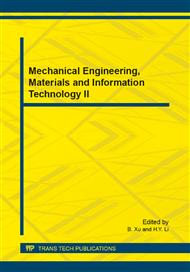[1]
Fisher R V, Schmincke H-U. Pyroclacstic rocks. Springer-verlag (1984).
Google Scholar
[2]
Cas R A F, Wright J V. Volcanic successions. London: Allen & Unwin (1987).
Google Scholar
[3]
Smith G A, Fritz W J. Penrose Conference report: volcanic influences on terrestrial sedimentation. Geology, 17 (3 ), (1989), 75-376.
Google Scholar
[4]
Pierson T C, Costa J E. A rheologic classification of subaerial sediment–water flows. in: Debris Flows/Avalanches: Process, Recognition and Mitigation, editied by Costa J E, Wieczorek G E, Geological Society of America. Review of Engineering Geology, USA (1987).
DOI: 10.1130/reg7-p1
Google Scholar
[5]
Pierson T C. Flow characteristics of large eruption-triggered debrisflows at snow-clad volcanoes: constraints for debris-flow models. Journal of Volcanology and Geothermal Research, 66, (1990), 283-294.
DOI: 10.1016/0377-0273(94)00070-w
Google Scholar
[6]
Voight B. The 1985 Nevado del Ruiz volcano catastrophe: anatomy and retrospection. Journal of Volcanology and Geothermal Research, 42, (1990a), 151-188.
DOI: 10.1016/0377-0273(90)90075-q
Google Scholar
[7]
Voight B. The 1985 Nevado del Ruiz volcano catastrophe: anatomy and retrospection. Journal of Volcanology and Geothermal Research, 44, (1990b), 1349-1386.
DOI: 10.1016/0377-0273(90)90027-d
Google Scholar
[8]
Kevin M S. Origins, behavior, and sedimentology of lahars and lahar-runout flows in the Toutle-Cowlitz river system. U.S. Geological suvey professional paper, 1447-A, Washington: United States Goverment Pringting Office (1988).
DOI: 10.3133/pp1447a
Google Scholar
[9]
Kevin M S. Magnitude and frequency of lahars and lahar-runout flows in the Toutle-Cowlitz river system. U.S. Geological survey professional paper, 1447-B, Washington: United States Goverment Pringting Office (1989).
DOI: 10.3133/pp1447b
Google Scholar
[10]
Kevin M S, et al. Sedimentology, behavior, and hazards of debris flows at Mount Rainier. Washington: U. S. geological survey professional paper, 1547, Washington: United States Goverment Pringting Office (1995).
DOI: 10.3133/pp1547
Google Scholar
[11]
Castruccio A, et al. Comparative study of lahars generated by the 1961 and 1971 eruptions of Calbuco and Villarrica volcanoes, Southern Andes of Chile. Journal of Volcanology and Geothermal Research, 190, (2010), 297–311.
DOI: 10.1016/j.jvolgeores.2009.12.005
Google Scholar
[12]
Carrivick J L, et al. Coupled fluid dynamics-sediment transport modelling of aCrater Lake break-out lahar: Mt. Ruapehu, New Zealand. Journal of Hydrology, 388, (2010), 399–413.
DOI: 10.1016/j.jhydrol.2010.05.023
Google Scholar
[13]
Procter J N, et al. Lahar hazard assessment using Titan2D for an alluvial fan with rapidly changing geomorphology: Whangaehu River, Mt. Ruapehu. Geomorphology, 116 (2010), 162–174.
DOI: 10.1016/j.geomorph.2009.10.016
Google Scholar
[14]
Yang Qingfu, et al. Assessment of potential volcanic hazards of the Tianchi volcano, Changbai Mountains. Geological Review, 45(sup), (1999), 215-221 (in Chinese).
Google Scholar
[15]
Nie Baofeng, et al. The characteristics of lahar deposits at Tianchi volcano. Journal of Capital Normal University ( Natural Science Edition ), 30(1), (1999), 70-75 (in Chinese).
Google Scholar
[16]
Wan Yuan, et al. Analysis to the lahars extent of Tianchi volcano at Changbai Mountains by numerical simulation. Journ al of Jilin University (Earth Science Edition), 41(5), (2001), 1638-1645 (in Chinese).
Google Scholar


